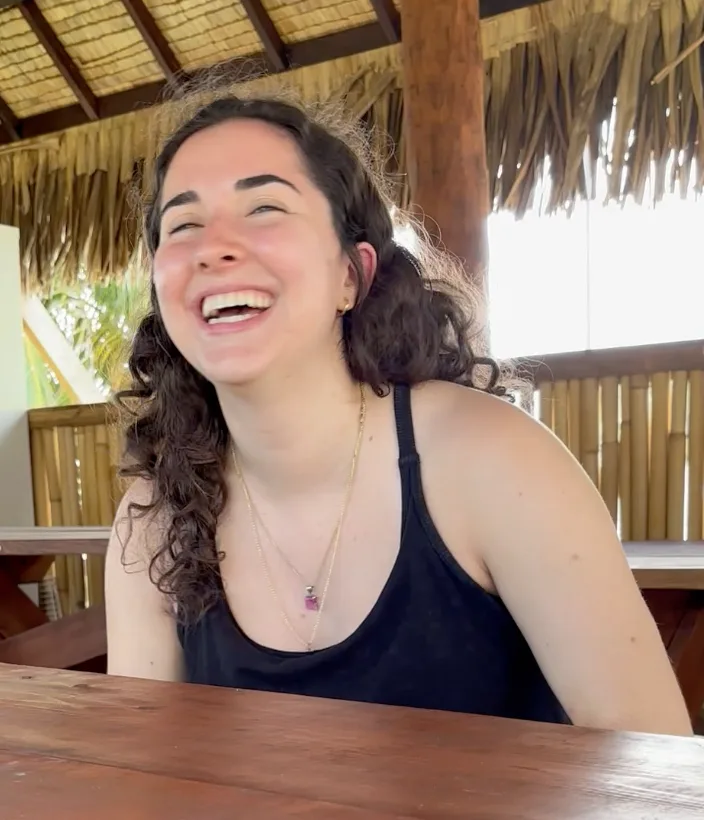Programs Blog
Elle on the Criobe Research Institute

Date: May 21, 2025
Time: 0615
Location: Gump Marine Station, Mo‘orea
Weather: 74˚ F, 5 kts from the east
This is a short interview with Elle Lansing, of Lafayette College.
What do you think of Mo‘orea so far?
It’s beautiful. Love it! The water is warm. I saw a lot of things at the beach—I brought my goggles. I’m looking forward to exploring more. Gump Marine Station is really cool. There’s a lot of really different parts of it. I like when we’re all together, all get to eat together.
Yesterday we toured the CRIOBE, a marine laboratory and research institute here that is funded by the French government, allowing doctoral students, postdocs, really any researchers to come and conduct research on water quality, coral, fish, whatever interests them. Biomolecule Technician and Lab Manager Benoit Espiau showed us around. Tell us about this visit.
We toured a bunch of different lab spaces, learning about the technology in each one, most of which we know a little about. I was surprised how much they actually had. It was cool, seeing the probes (which they leave underwater to monitor, sometimes for two years), and the pipette room. The ocean acidification lab was cool. They go out in their boats to sample. In the back was a wet lab with tanks. The urchin project was neat. They had ALL the dive equipment, too. And it was funny when he said to our group at the end, “Come back, work here!” A lot of us liked that idea. That would be cool! I was kind of surprised that it covers all of French Polynesia, there are so many islands.
Will you explain your project for the Ocean Science and Public Policy course? You did something with oil drilling around Aotearoa New Zealand?
Yes, we are the ‘oil and gas group,’ with Aimee and Patricia. We researched the Crown Minerals Act and the amendment to the act. We presented both sides to either keeping the current ban on oil drilling or reversing this ban. One side focused on preserving natural gas and other resources, while the other side focused on the effects of burning oil and marine protection. So it was kind of like an economic vs. environmental thing. We finished with a suggestion to policy makers in New Zealand. Obviously, they have a different government than we do. We tried not to oversimplify, but tried to keep it to just two different sides. So it was less confusing. This morning our professor Erin Bryant zoomed in, and we revised our policy brief, which is in the draft of our edition of SEA Writer magazine. (Coming out late June!)


Recent Posts from the Ships
- Ocean Classroom 2024-A collaborative high school program with Proctor Academy
- Collaborations and Long-term Commitments: SEA’s Caribbean Reef Program Sets a Course for Coastal Programs that Compliment Shipboard Experiences.
- Sea Education Association students prepare for life underway using state of the art nautical simulation from Wartsila Corporation.
- SEA Writer 2022, Magazines From the Summer SEA Quest Students
- Technology@SEA: Upgrades Allow Insight into Ocean Depths
Programs
- Gap Year
- Ocean Exploration
- High School
- Science at SEA
- SEA Expedition
- SEAScape
- Pre-College
- Proctor Ocean Classroom
- Protecting the Phoenix Islands
- SPICE
- Stanford@SEA
- Undergraduate
- Climate and Society
- Climate Change and Coastal Resilience
- Coral Reef Conservation
- Marine Biodiversity and Conservation
- MBL
- Ocean Exploration: Plastics
- Ocean Policy: Marine Protected Areas
- Oceans and Climate
- Pacific Reef Expedition
- The Global Ocean: Hawai'i
- The Global Ocean: New Zealand